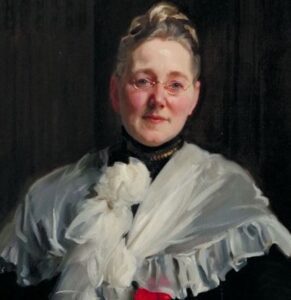Howard Fischer
Uppsala, Sweden
 |
| Mary Elizabeth Garrett. Bust from portrait by John Singer Sargent. Via Wikimedia. |
“For to this lady, more than any other single person, save Johns Hopkins himself, does the School of Medicine owe its being.”1
– Alan Chesney on Mary Elizabeth Garrett
Johns Hopkins (1795–1873) was born in Maryland, one of eleven children of a Quaker couple. His father was a tobacco planter. Johns’ first job was as a helper to his uncle, a grocer. They quarreled, and Hopkins left. After years of thrift, hard work, and careful investments in tobacco and real estate, he became a banker and a millionaire.2,3 He never married, and so had no wife nor children to inherit his wealth. He left seven million dollars to establish a university and a hospital in Baltimore, as well as an orphanage for Black children.4
He stipulated that the hospital was to provide care to people regardless of race, sex, age, or ability to pay. He was considered Baltimore’s greatest philanthropist of his time. The university opened in 1870, the hospital in 1889. It was the largest medical center in the US, with seventeen buildings, 330 beds, and twenty-five physicians.5,6
Before organizing the medical school, Johns Hopkins University dean Daniel Coit Gilman asked eminent British physicians how medical education could be improved.7 What became the educational philosophy of the Johns Hopkins University School of Medicine was “a radical departure from the old regime.” Medicine was to be “a field of graduate study, rooted in basic science and hospital medicine.”8 The faculty were men accomplished in research “wooed from outside Baltimore,” rather than local practitioners, “as had always been the pattern in America.” The Johns Hopkins University School of Medicine “joined science and research ever more firmly to clinical hospital practice.”9 Historian of education Thomas Bonner wrote of “the happy coming together of the English clerkship and the German laboratory at Baltimore.”10
The money for the construction and equipping of the medical school came mainly from dividends paid on Baltimore and Ohio railroad stock. With an economic downturn in the late 1880s, the stock stopped paying dividends, and the money ran out.
Mary Elizabeth Garrett (1854–1915), who came from one of America’s wealthiest families, and her three friends raised $100,000 for the School of Medicine, half of which came from Ms. Garrett’s personal funds. She saw that the school’s “financial crisis offered a unique opportunity to advance the cause of women’s education while at the same time rescuing the hospital from its financial dilemma.”11 This money would be given to the School of Medicine only if women were accepted as medical students on the same basis as men. After much resistance, the school’s board of governors reluctantly accepted the deal. After a further two years of fundraising, the additional $500,000 needed had not been raised. Mary Garrett then gave the School of Medicine $300,000 on the condition that students were admitted only after four years of college study that included botany, chemistry, and physics. A reading knowledge of French and German were also required.12 Dr. William Osler, an illustrious member of the founding faculty, wrote that he would never have been admitted under such rigorous standards. Even more reluctantly, the board accepted Ms. Garrett’s “coercive philanthropy.”13
Johns Hopkins became the first US medical school that mandated a college degree for entry, and that had a full-time teaching staff.14 The school opened in 1893. Furthermore, surgeon and author Sherwin Nuland writes:
When American medical schools began to pattern themselves after Hopkins in the first third of the twentieth-century, they took on the very high standards, but regrettably had no interest in admitting women on the same basis as men.15
References
- Alan Chesney. The Johns Hopkins Hospital and The Johns Hopkins University School of Medicine: A Chronicle. Volume 1, 1867–1893. Baltimore, MD: Johns Hopkins Press, 1943. Quoted in: William Jarrett. “Raising the bar: Mary Elizabeth Garrett, M. Carey Thomas, and the Johns Hopkins Medical School.” Proceedings (Baylor University Medical Center) 24(1), 2011.
- Johns Hopkins Medicine. “Who was Johns Hopkins?” https://www.hopkinsmedicine.org/about/history/johns-hopkins.html.
- “Johns Hopkins.” Encyclopedia Britannica.
- “Johns Hopkins,” Encyclopedia Britannica.
- Johns Hopkins University School of Medicine Founding Documents. Johns Hopkins Sheridan Library. https://jscholarship.library.jhu.edu/handle/1774.2/44451.
- “Johns Hopkins,” Encyclopedia Britannica.
- Thomas Bonner. Becoming a Physician: Medical Education in Great Britain, France, Germany and the United States, 1750-1945. New York: Oxford University Press, 1995.
- Paul Starr. The Social Transformation of American Medicine. New York: Basic Books, 1982.
- Starr, Social Transformation.
- Thomas Bonner, Becoming a Physician.
- Alla Kulichenko. “Johns Hopkins University School of Medicine and American Feminist Movement in the Late 19th” Abstract. 1st Young Researchers International Web Conference: Language, Culture, Communication in the Expanding Intellectual Space, March 20, 2019.
- Sherwin Nuland. Doctors: The Illustrated History of Medical Pioneers. New York: Black Dog and Leventhal Publishers, 1988.
- “Mary Garrett.” Wikipedia.
- Kathleen Sander. “A Pleasure to be Bought.” Johns Hopkins Magazine 60(4), September 2008. https://pages.jh.edu/jhumag/0908web/garrett.html.
- Sherwin Nuland. The Soul of Medicine: Tales from the Bedside. New York: Kaplan Publishing, 2009.
HOWARD FISCHER, MD, was a professor of pediatrics at Wayne State University School of Medicine, Detroit, Michigan.

Leave a Reply